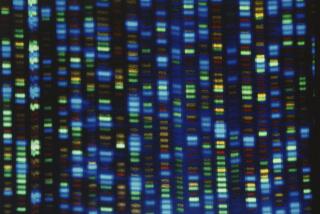Timeline Shows the Trials and Errors of Treating Diabetes
- Share via
Every so often, we are honored to help out a reader in this column. Once someone sent in one of her hairs (they’d gone white, and she wanted to know why). Another time a couple having a marital dispute asked about the right way to clean a chopping board. This week’s query is about diabetes--a far more serious topic, since the malady affects 17 million people in the U.S. alone. “When,” asks a reader, “was the disease discovered, and from that time, what efforts were made to manage it?”
At your service, Mr. Fuller.
First, about that name: Diabetes is Greek for “siphoning,” or “go through.” The term was coined around 250 BC because of the excessive urination.
But people knew about the ailment far earlier--had noted the urination, crazed thirst and wasting of the flesh at least as far back as 1500 BC. The Hindus even noted that ants could help out with diagnosis. Black ants (and flies) were unusually attracted to the sufferer’s urine because of all the sugar in it.
Thus, the reason for the second part of the name: mellitus, Latin for “honey.”
No one knew what caused it (namely, improper production or responses to a key sugar-regulating hormone--insulin--made by the pancreas). But they certainly waxed theoretical. Aretaeus of Cappadocia, a 2nd century Greek physician, seemed to believe that the flow of urine and the body’s wasting were intricately linked. “Many parts of the flesh pass out along with the urine,” he wrote.
Diabetes was awful in ancient times. A kid coming down with it would often last mere days.
Not that medical sages of the times weren’t trying. Over the centuries, they threw a plethora of herbs, salves and other remedies at the disorder. Aretaeus thought the key was to stymie the excessive thirst by strengthening the stomach with purging, plant infusions and acidic wine. The 7th century Greek physician Paul of Aegena prescribed “pot-herbs, endive, lettuce, rock-fishes, juices of knotgrass, elecampane in dark-colored wine and dedoctions of dates and myrtle.” He also recommended “cataplasms to the hypochondrium”--which sound nasty but in fact were merely poultices applied to the abdomen.
The 10th century Persian physician Avicenna recommended exercise--ideally on horseback--to provide friction and thus to temper the incessant urination.
Much later, after bleeding, blistering, vein-cutting and more were also touted as helpful, doctors tried with a small measure of success to control the ailment using low-carbohydrate diets. Only in the early 20th century did scientists finally purify insulin.
Here are a few high points in the diabetes discovery timeline:
* In 1869, the German anatomist Paul Langerhans discovered some distinctive structures in the pancreas--though he didn’t know what they were for. To this day, they’re known as the “islets of Langerhans.”
* In 1899, two other German scientists--Joseph von Mering and Oscar Minkowski--discovered that removing the pancreas from a dog resulted in a diabetic dog. It was an accidental discovery: The two were merely trying to figure out the pancreas’ role in digestion.
* Insulin--the hormone made by the Langerhans islets--was purified in the early ‘20s by four scientists in Canada: Frederick Grant Banting, John James Richard Macleod, Charles Herbert Best and James B. Collip. They’d figured out a way to extract the hormone without it getting chewed up by other enzymes.
When they gave their extract to dogs without pancreases, those dogs survived for months instead of mere days--though if given too much, they’d lapse into comas. A dose of glucose would save them.
The first human patient, in 1922, was a 14-year-old boy with diabetes. He reacted badly to the early preparations, developing abscesses on the injection site, and more. But after Collip further purified the extract, he did well--lived, indeed, for another 13 years.
A Nobel Prize for insulin was awarded in 1923, but it ticked off a lot of scientists. Some raged about the omission of names like Von Mering and Minkowski. And they raged about other omissions. Only Banting and Macleod got the prize, even though Best, by all accounts, had done more work than Macleod. Banting was furious.
In the end, Banting shared his prize money with Best, and Macleod shared his with Collip. But that wasn’t the end of the bad blood. Banting and Collip once came to physical blows after Collip refused to divulge some of his insulin-purification methods. Bickering among the four continued for years.
To learn more about diabetes history, go to www.nobel.se/medicine/laureates/1923; www.post gradmed.com/issues/1997/04_97/ diabetes.htm; and “The Discovery of Insulin,” by Michael Bliss (University of Chicago Press, 1984).
If you have an idea for a Booster Shots topic, write or e-mail Rosie Mestel at the Los Angeles Times, 202 W. 1st. St., Los Angeles, CA 90012, [email protected].






